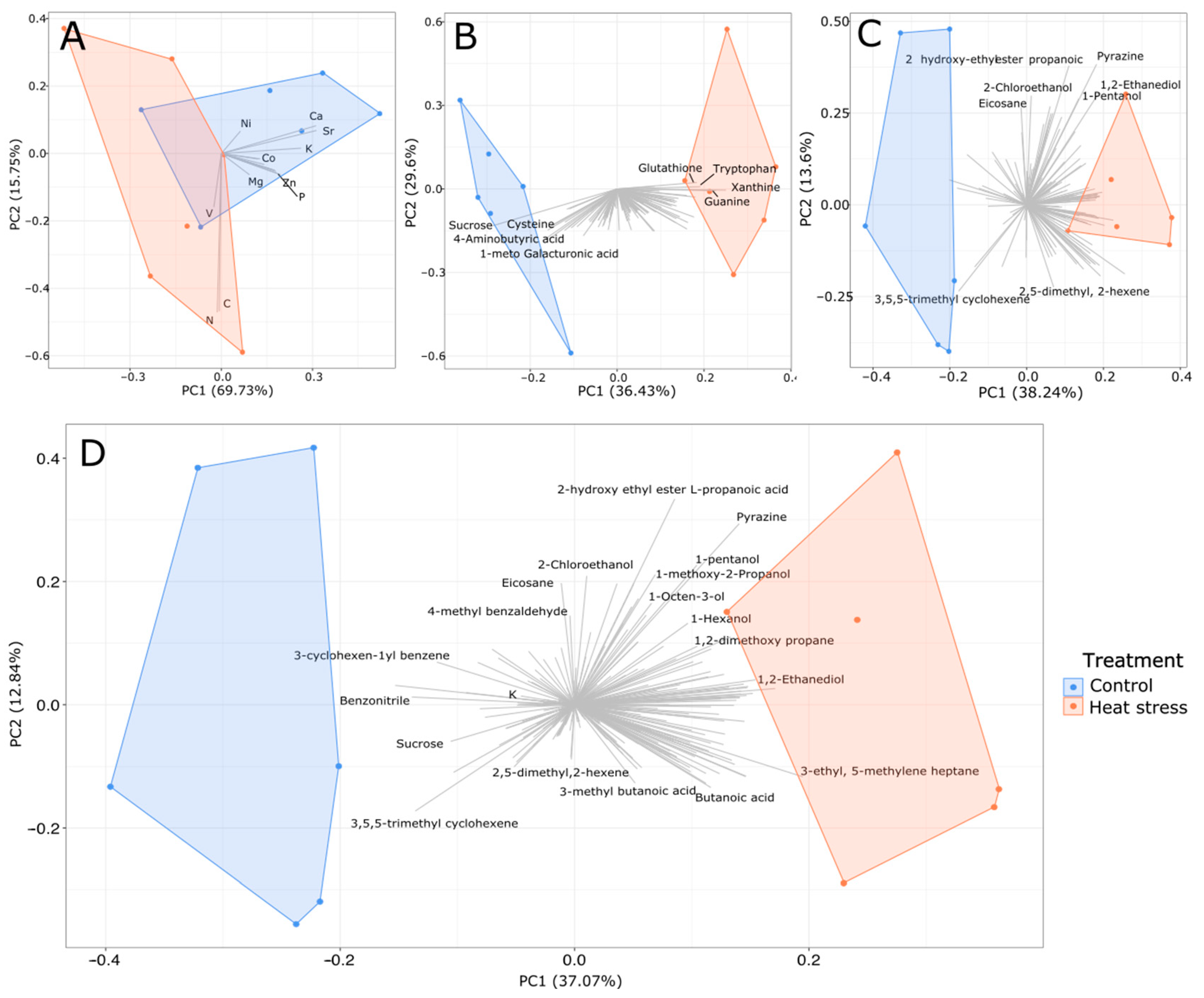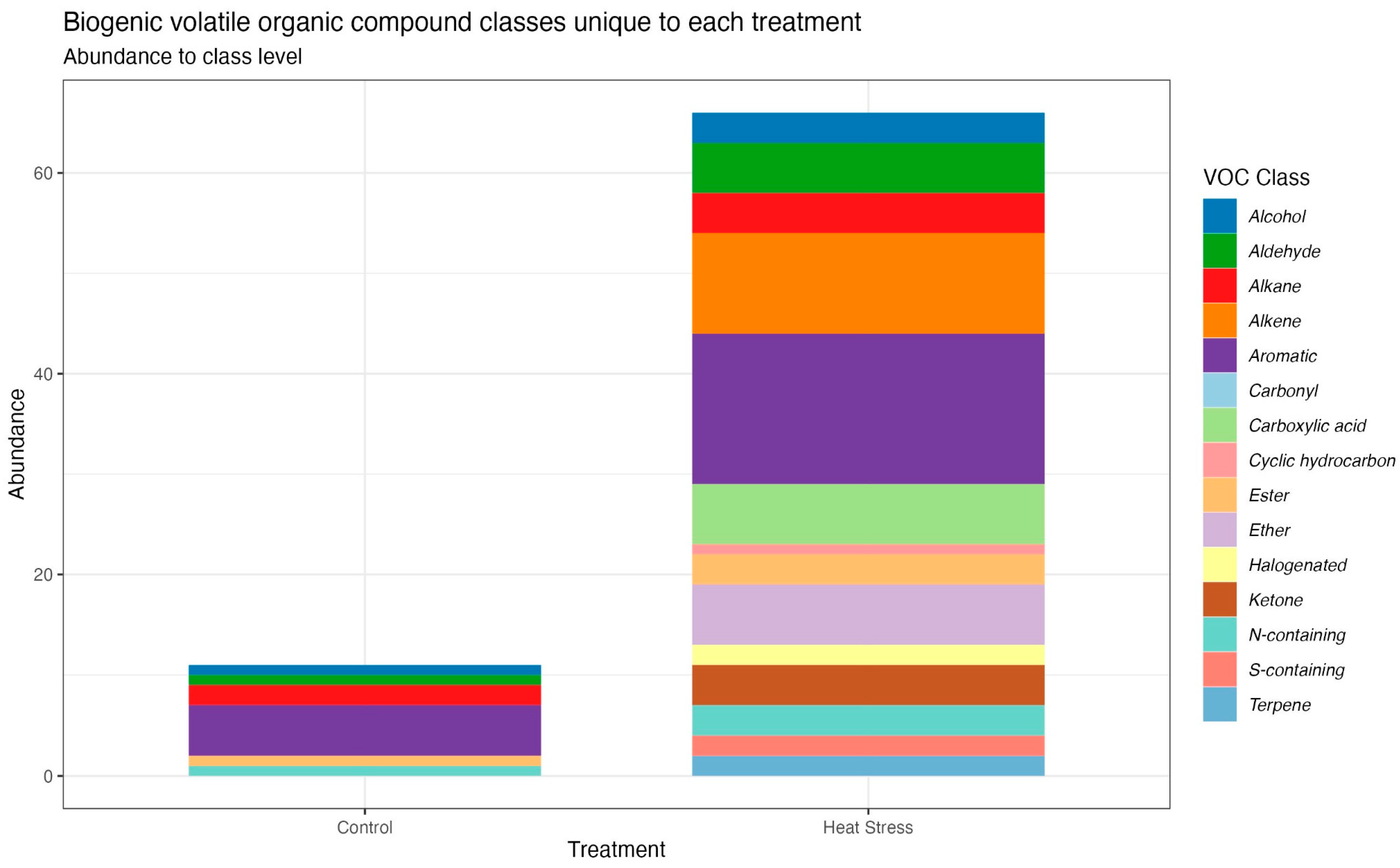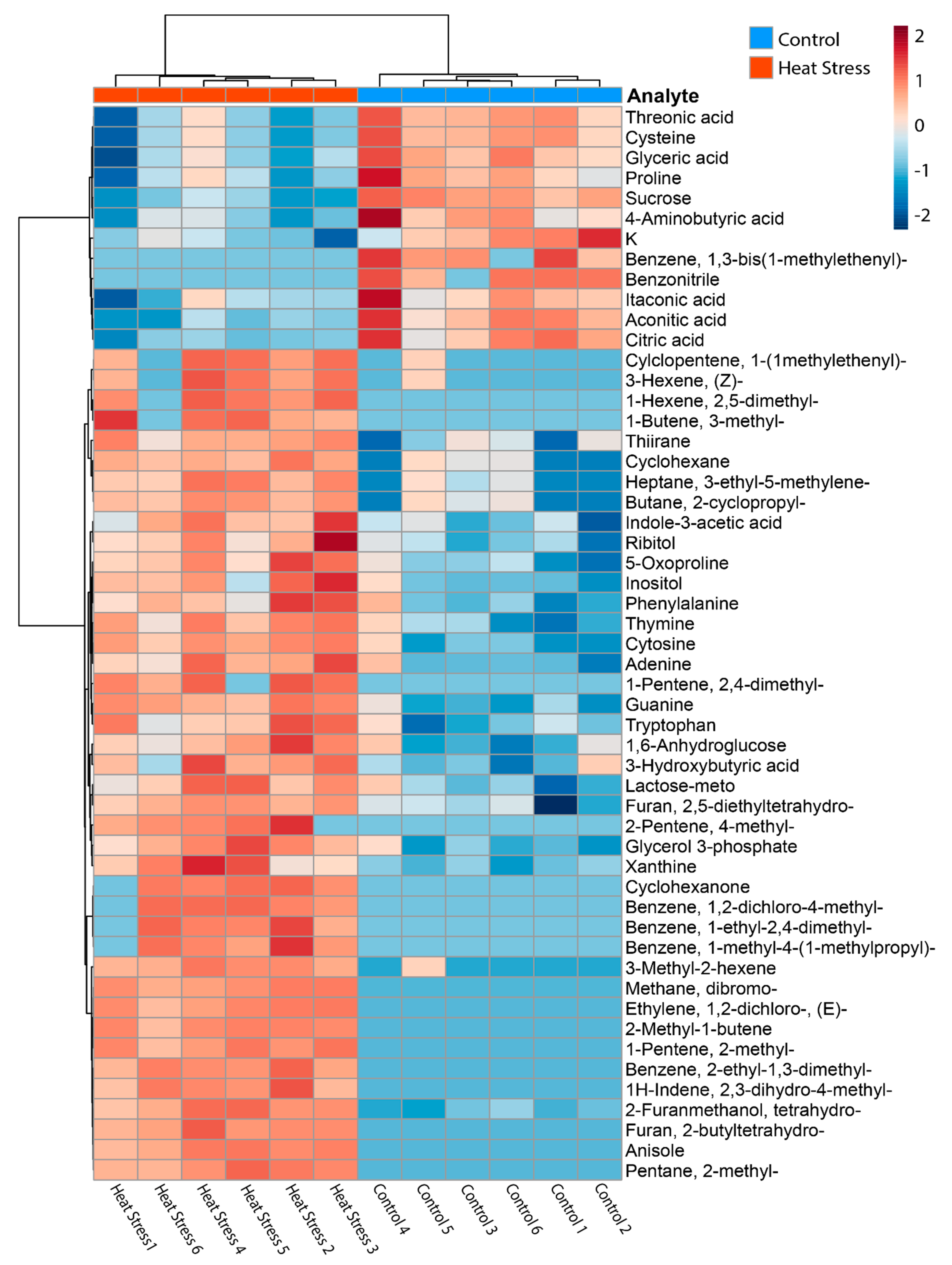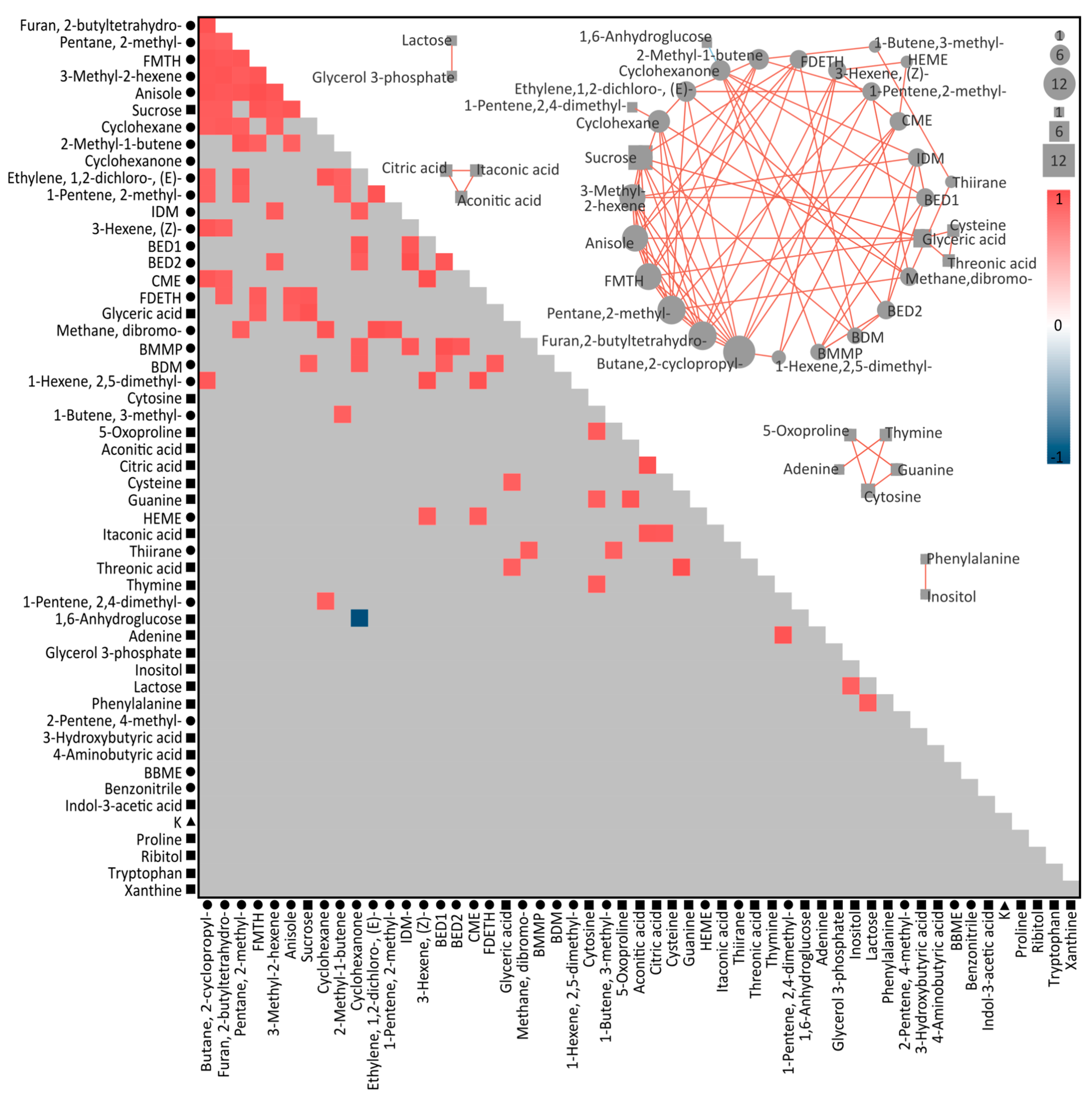Multi-Chemical Omics Analysis of the Symbiodiniaceae Durusdinium trenchii under Heat Stress
Abstract
:1. Introduction
2. Materials and Methods
2.1. Culturing and Experimental Conditions
2.2. Photophysiology
2.3. Symbiodiniaceae and Bacterial Cell Density Analysis
2.4. Elementomics Data Collection and Analysis
2.5. Metabolomics Data Collection and Analysis
2.6. Online Derivatisation and Gas Chromatography-Mass Spectrometry Analysis
2.7. Metabolite Data Analysis
2.8. Volatile Sample Collection
2.9. GC×GC-TOFMS Analysis of BVOCs
2.10. BVOC Data Pre-Processing
2.11. Integration Analysis and Statistics
2.12. Correlation and Network Analysis
3. Results
3.1. Symbiodiniaceae Photophysiology
3.2. Chemical Omics Approaches in Isolation
3.3. Integration of Chemical Omics Approaches
3.4. Correlation and Network Analysis
4. Discussion
Supplementary Materials
Author Contributions
Funding
Data Availability Statement
Acknowledgments
Conflicts of Interest
References
- Scheffers, B.R.; De Meester, L.; Bridge, T.C.L.; Hoffmann, A.A.; Pandolfi, J.M.; Corlett, R.T.; Butchart, S.H.M.; Pearce-Kelly, P.; Kovacs, K.M.; Dudgeon, D.; et al. The broad footprint of climate change from genes to biomes to people. Science 2016, 354, aaf7671. [Google Scholar] [CrossRef] [PubMed]
- GCRMN. Status of Coral Reefs of the World, 2020: Executive Summary; Core Writing Team, Souter, D., Planes, S., Wicquart, J., Logan, M., Obura, D., Staub, F., Eds.; GCRMN: Naples, Italy, 2020; Available online: https://gcrmn.net/wp-content/uploads/2022/05/Executive-Summary-with-Forewords.pdf (accessed on 2 August 2023).
- Mcleod, E.; Anthony, K.R.N.; Mumby, P.J.; Maynard, J.; Beeden, R.; Graham, N.A.J.; Heron, S.F.; Hoegh-Guldberg, O.; Jupiter, S.; MacGowan, P.; et al. The future of resilience-based management in coral reef ecosystems. J. Environ. Manag. 2019, 233, 291–301. [Google Scholar] [CrossRef] [PubMed]
- Camp, E.F. Contingency planning for coral reefs in the Anthropocene; The potential of reef safe havens. Emerg. Top. Life Sci. 2022, 6, 107–124. [Google Scholar] [CrossRef] [PubMed]
- Voolstra, C.R.; Suggett, D.J.; Peixoto, R.S.; Parkinson, J.E.; Quigley, K.M.; Silveira, C.B.; Sweet, M.; Muller, E.M.; Barshis, D.J.; Bourne, D.G.; et al. Extending the natural adaptive capacity of coral holobionts. Nat. Rev. Earth Environ. 2021, 2, 747–762. [Google Scholar] [CrossRef]
- Ainsworth, T.D.; Fordyce, A.J.; Camp, E.F. The other microeukaryotes of the coral reef microbiome. Trends Microbiol. 2017, 25, 980–991. [Google Scholar] [CrossRef] [PubMed]
- Goulet, T.L.; Erill, I.; Ascunce, M.S.; Finley, S.J.; Javan, G.T. Conceptualization of the holobiont paradigm as it pertains to corals. Front. Physiol. 2020, 11, 1156. [Google Scholar] [CrossRef] [PubMed]
- Durante, M.K.; Baums, I.B.; Williams, D.E.; Vohsen, S.; Kemp, D.W. What drives phenotypic divergence among coral clonemates of Acropora palmata? Mol. Ecol. 2019, 28, 3208–3224. [Google Scholar] [CrossRef]
- Camp, E.F.; Nitschke, M.R.; Clases, D.; Gonzalez de Vega, R.; Reich, H.G.; Goyen, S.; Suggett, D.J. Micronutrient content drives elementome variability amongst the Symbiodiniaceae. BMC Plant Biol. 2022, 22, 184. [Google Scholar] [CrossRef]
- Takahashi, S.; Whitney, S.M.; Badger, M.R. Different thermal sensitivity of the repair of photodamaged photosynthetic machinery in cultured Symbiodinium species. Proc. Natl. Acad. Sci. USA 2009, 106, 3237–3242. [Google Scholar] [CrossRef]
- Reich, H.G.; Rodriguez, I.B.; LaJeunesse, T.C.; Ho, T.-Y. Endosymbiotic dinoflagellates pump iron: Differences in iron and other trace metal needs among the Symbiodiniaceae. Coral Reefs 2020, 39, 915–927. [Google Scholar] [CrossRef]
- Ros, M.; Suggett, D.J.; Edmondson, J.; Haydon, T.; Hughes, D.J.; Kim, M.; Guagliardo, P.; Bougoure, J.; Pernice, M.; Raina, J.-B.; et al. Symbiont shuffling across environmental gradients aligns with changes in carbon uptake and translocation in the reef-building coral Pocillopora acuta. Coral Reefs 2021, 40, 595–607. [Google Scholar] [CrossRef]
- Nitschke, M.R.; Rosset, S.L.; Oakley, C.A.; Gardner, S.G.; Camp, E.F.; Suggett, D.J.; Davy, S.K. The diversity and ecology of Symbiodiniaceae: A traits-based review. Adv. Mar. Biol. 2022, 92, 55–127. [Google Scholar]
- Muscatine, L.; Cernichiari, E. Assimilation of photosynthetic products of zooxanthellae by a reef coral. Biol. Bull. 1969, 137, 506–523. [Google Scholar] [CrossRef] [PubMed]
- Davies, P.S. The role of zooxanthellae in the nutritional energy requirements of Pocillopora eydouxi. Coral Reefs 1984, 2, 181–186. [Google Scholar] [CrossRef]
- Matthews, J.L.; Crowder, C.M.; Oakley, C.A.; Lutz, A.; Roessner, U.; Meyer, E.; Grossman, A.R.; Weis, V.M.; Davy, S.K. Optimal nutrient exchange and immune responses operate in partner specificity in the cnidarian-dinoflagellate symbiosis. Proc. Natl. Acad. Sci. USA 2017, 114, 13194–13199. [Google Scholar] [CrossRef] [PubMed]
- Sampayo, E.M.; Ridgway, T.; Bongaerts, P.; Hoegh-Guldberg, O. Bleaching susceptibility and mortality of corals are determined by fine-scale differences in symbiont type. Proc. Natl. Acad. Sci. USA 2008, 105, 10444–10449. [Google Scholar] [CrossRef]
- Abrego, D.; Ulstrup, K.E.; Willis, B.L.; van Oppen, M.J.H. Species-specific interactions between algal endosymbionts and coral hosts define their bleaching response to heat and light stress. Proc. Biol. Sci. 2008, 275, 2273–2282. [Google Scholar] [CrossRef]
- Chan, W.Y.; Meyers, L.; Rudd, D.; Topa, S.H.; van Oppen, M.J.H. Heat-evolved algal symbionts enhance bleaching tolerance of adult corals without trade-off against growth. Glob. Chang. Biol. 2023, 29, 6945–6968. [Google Scholar] [CrossRef]
- Tanvet, C.; Camp, E.F.; Sutton, J.; Houlbrèque, F.; Thouzeau, G.; Rodolfo-Metalpa, R. Corals adapted to extreme and fluctuating seawater pH increase calcification rates and have unique symbiont communities. Ecol. Evol. 2023, 13, e10099. [Google Scholar] [CrossRef] [PubMed]
- Dilernia, N.J.; Camp, E.F.; Bartels, N.; Suggett, D.J. Contrasting the thermal performance of cultured coral endosymbiont photo-physiology. J. Exp. Mar. Biol. Ecol. 2023, 561, 151865. [Google Scholar] [CrossRef]
- Suggett, D.J.; Goyen, S.; Evenhuis, C.; Szabó, M.; Pettay, D.T.; Warner, M.E.; Ralph, P.J. Functional diversity of photobiological traits within the genus Symbiodinium appears to be governed by the interaction of cell size with cladal designation. New Phytol. 2015, 208, 370–381. [Google Scholar] [CrossRef] [PubMed]
- Reich, H.G.; Tu, W.-C.; Rodriguez, I.B.; Chou, Y.; Keister, E.F.; Kemp, D.W.; LaJeunesse, T.C.; Ho, T.-Y. Iron availability modulates the response of endosymbiotic dinoflagellates to heat stress. J. Phycol. 2021, 57, 3–13. [Google Scholar] [CrossRef] [PubMed]
- Rodriguez, I.B.; Lin, S.; Ho, J.; Ho, T.-Y. Effects of Trace Metal Concentrations on the Growth of the Coral Endosymbiont Symbiodinium kawagutii. Front. Microbiol. 2016, 7, 82. [Google Scholar] [CrossRef] [PubMed]
- Madin, J.S.; Hoogenboom, M.O.; Connolly, S.R.; Darling, E.S.; Falster, D.S.; Huang, D.; Keith, S.A.; Mizerek, T.; Pandolfi, J.M.; Putnam, H.M.; et al. A Trait-Based Approach to Advance Coral Reef Science. Trends Ecol. Evol. 2016, 31, 419–428. [Google Scholar] [CrossRef] [PubMed]
- Camp, E.F.; Kahlke, T.; Signal, B.; Oakley, C.A.; Lutz, A.; Davy, S.K.; Suggett, D.J.; Leggat, W.P. Proteome metabolome and transcriptome data for three Symbiodiniaceae under ambient and heat stress conditions. Sci. Data 2022, 9, 153. [Google Scholar] [CrossRef]
- Davies, S.W.; Gamache, M.H.; Howe-Kerr, L.I.; Kriefall, N.G.; Baker, A.C.; Banaszak, A.T.; Bay, L.K.; Bellantuono, A.J.; Bhattacharya, D.; Chan, C.X.; et al. Building consensus around the assessment and interpretation of Symbiodiniaceae diversity. PeerJ 2023, 11, e15023. [Google Scholar] [CrossRef]
- Aranda, M.; Li, Y.; Liew, Y.J.; Baumgarten, S.; Simakov, O.; Wilson, M.C.; Piel, J.; Ashoor, H.; Bougouffa, S.; Bajic, V.B.; et al. Genomes of coral dinoflagellate symbionts highlight evolutionary adaptations conducive to a symbiotic lifestyle. Sci. Rep. 2016, 6, 39734. [Google Scholar] [CrossRef]
- Lin, S.; Cheng, S.; Song, B.; Zhong, X.; Lin, X.; Li, W.; Li, L.; Zhang, Y.; Zhang, H.; Ji, Z.; et al. The Symbiodinium kawagutii genome illuminates dinoflagellate gene expression and coral symbiosis. Science 2015, 350, 691–694. [Google Scholar] [CrossRef]
- Liu, H.; Stephens, T.G.; González-Pech, R.A.; Beltran, V.H.; Lapeyre, B.; Bongaerts, P.; Cooke, I.; Aranda, M.; Bourne, D.G.; Forêt, S.; et al. Symbiodinium genomes reveal adaptive evolution of functions related to coral-dinoflagellate symbiosis. Commun. Biol. 2018, 1, 95. [Google Scholar] [CrossRef]
- Shoguchi, E.; Shinzato, C.; Kawashima, T.; Gyoja, F.; Mungpakdee, S.; Koyanagi, R.; Takeuchi, T.; Hisata, K.; Tanaka, M.; Fujiwara, M.; et al. Draft assembly of the Symbiodinium minutum nuclear genome reveals dinoflagellate gene structure. Curr. Biol. 2013, 23, 1399–1408. [Google Scholar] [CrossRef]
- González-Pech, R.A.; Stephens, T.G.; Chen, Y.; Mohamed, A.R.; Cheng, Y.; Shah, S.; Dougan, K.E.; Fortuin, M.D.A.; Lagorce, R.; Burt, D.W.; et al. Comparison of 15 dinoflagellate genomes reveals extensive sequence and structural divergence in family Symbiodiniaceae and genus Symbiodinium. BMC Biol. 2021, 19, 73. [Google Scholar] [CrossRef]
- Reich, H.G.; Kitchen, S.A.; Stankiewicz, K.H.; Devlin-Durante, M.; Fogarty, N.D.; Baums, I.B. Genomic variation of an endosymbiotic dinoflagellate (Symbiodinium “fitti”) among closely related coral hosts. Mol. Ecol. 2021, 30, 3500–3514. [Google Scholar] [CrossRef]
- Avila-Magaña, V.; Kamel, B.; DeSalvo, M.; Gómez-Campo, K.; Enríquez, S.; Kitano, H.; Rohlfs, R.V.; Iglesias-Prieto, R.; Medina, M. Elucidating gene expression adaptation of phylogenetically divergent coral holobionts under heat stress. Nat. Commun. 2021, 12, 5731. [Google Scholar] [CrossRef]
- Bayer, T.; Aranda, M.; Sunagawa, S.; Yum, L.K.; Desalvo, M.K.; Lindquist, E.; Coffroth, M.A.; Voolstra, C.R.; Medina, M. Symbiodinium transcriptomes: Genome insights into the dinoflagellate symbionts of reef-building corals. PLoS ONE 2012, 7, e35269. [Google Scholar] [CrossRef] [PubMed]
- Parkinson, J.E.; Baumgarten, S.; Michell, C.T.; Baums, I.B.; LaJeunesse, T.C.; Voolstra, C.R. Gene expression variation resolves species and individual strains among coral-associated dinoflagellates within the genus Symbiodinium. Genome Biol. Evol. 2016, 8, 665–680. [Google Scholar] [CrossRef]
- Lawson, C.A.; Camp, E.; Davy, S.K.; Ferrier-Pagès, C. Informing Coral Reef Conservation through Metabolomic Approaches. In Coral Reef Conservation; Springer: Berlin/Heidelberg, Germany, 2022; Available online: https://link.springer.com/chapter/10.1007/978-3-031-07055-6_12 (accessed on 2 August 2023).
- Sproles, A.E.; Oakley, C.A.; Matthews, J.L.; Peng, L.; Owen, J.G.; Grossman, A.R.; Weis, V.M.; Davy, S.K. Proteomics quantifies protein expression changes in a model cnidarian colonised by a thermally tolerant but suboptimal symbiont. ISME J. 2019, 13, 2334–2345. [Google Scholar] [CrossRef] [PubMed]
- Wuerz, M.; Lawson, C.A.; Oakley, C.A.; Possell, M.; Wilkinson, S.P.; Grossman, A.R.; Weis, V.M.; Suggett, D.J.; Davy, S.K. Symbiont identity impacts the microbiome and volatilome of a model cnidarian-dinoflagellate symbiosis. Biology 2023, 12, 1014. [Google Scholar] [CrossRef] [PubMed]
- Harrison, P.J.; Waters, R.E.; Taylor, F.J.R. A broad spectrum artificial sea water medium for coastal and open ocean phytoplankton1. J. Phycol. 1980, 16, 28–35. [Google Scholar] [CrossRef]
- Suggett, D.J.; Nitschke, M.R.; Hughes, D.J. Toward Bio-Optical Phenotyping of Reef-Forming Corals Using Light-Induced Fluorescence Transient-Fast Repetition Rate Fluorometry. Limnol. Oceanogr. Methods 2022, 20, 172–191. [Google Scholar] [CrossRef]
- IAEA. Clean Laboratories and Clean Rooms for Analysis of Radionuclides and Trace Elements; IAEA: Vienna, Austria, 2003. [Google Scholar]
- Matthews, J.L.; Khalil, A.; Siboni, N.; Bougoure, J.; Guagliardo, P.; Kuzhiumparambil, U.; DeMaere, M.; Le Reun, N.M.; Seymour, J.R.; Suggett, D.J.; et al. Coral endosymbiont growth is enhanced by metabolic interactions with bacteria. Nat. Commun. 2023, 14, 6864. [Google Scholar] [CrossRef]
- Lawson, C.A.; Possell, M.; Seymour, J.R.; Raina, J.-B.; Suggett, D.J. Coral endosymbionts (Symbiodiniaceae) emit species-specific volatilomes that shift when exposed to thermal stress. Sci. Rep. 2019, 9, 17395. [Google Scholar] [CrossRef] [PubMed]
- Bartels, N.; Matthews, J.L.; Lawson, C.A.; Possel, M.; Hughes, D.J.; Raina, J.-B.; Suggett, D.J. Paired metabolomic and volatilomics provide a comprehensive insight into transient light stress response mechanisms of the coral Montipora mollis. J. Exp. Biol. 2024; submitted. [Google Scholar]
- Shannon, P.; Markiel, A.; Ozier, O.; Baliga, N.S.; Wang, J.T.; Ramage, D.; Amin, N.; Schwikowski, B.; Ideker, T. Cytoscape: A software environment for integrated models of biomolecular interaction networks. Genome Res. 2003, 13, 2498–2504. [Google Scholar] [CrossRef]
- Redfield, A.C. The biological control of chemical factors in the environment. Am. Sci. 1958, 46, 230A, 205–221. [Google Scholar]
- Loreto, F.; Schnitzler, J.-P. Abiotic stresses and induced BVOCs. Trends Plant Sci. 2010, 15, 154–166. [Google Scholar] [CrossRef]
- Moore, R.M.; Webb, M.; Tokarczyk, R.; Wever, R. Bromoperoxidase and iodoperoxidase enzymes and production of halogenated methanes in marine diatom cultures. J. Geophys. Res. Ocean. 1996, 101, 20899–20908. [Google Scholar] [CrossRef]
- Goodwin, K.D.; Lidstrom, M.E.; Oremland, R.S. Marine bacterial degradation of brominated methanes. Environ. Sci. Technol. 1997, 31, 3188–3192. [Google Scholar] [CrossRef]
- Olander, A.; Lawson, C.A.; Possell, M.; Raina, J.B.; Ueland, M. Comparative volatilomics of coral endosymbionts from one-and comprehensive two-dimensional gas chromatography approaches. Mar. Biol. 2021, 168, 76. [Google Scholar] [CrossRef]
- Lawson, C.A.; Raina, J.-B.; Deschaseaux, E.; Hrebien, V.; Possell, M.; Seymour, J.R.; Suggett, D.J. Heat stress decreases the diversity, abundance and functional potential of coral gas emissions. Glob. Chang. Biol. 2021, 27, 879–891. [Google Scholar] [CrossRef]
- Camp, E.F.; Kahlke, T.; Nitschke, M.R.; Varkey, D.; Fisher, N.L.; Fujise, L.; Goyen, S.; Hughes, D.J.; Lawson, C.A.; Ros, M.; et al. Revealing changes in the microbiome of Symbiodiniaceae under thermal stress. Environ. Microbiol. 2020, 22, 1294–1309. [Google Scholar] [CrossRef]
- Matthews, J.L.; Oakley, C.A.; Lutz, A.; Hillyer, K.E.; Roessner, U.; Grossman, A.R.; Weis, V.M.; Davy, S.K. Partner switching and metabolic flux in a model cnidarian–dinoflagellate symbiosis. Proc. R. Soc. B Biol. Sci. 2018, 285, 20182336. [Google Scholar] [CrossRef]
- Klueter, A.; Crandall, J.B.; Archer, F.I.; Teece, M.A.; Coffroth, M.A. Taxonomic and environmental variation of metabolite profiles in marine dinoflagellates of the genus Symbiodinium. Metabolites 2015, 5, 74–99. [Google Scholar] [CrossRef]
- Hillyer, K.E.; Dias, D.; Lutz, A.; Roessner, U.; Davy, S.K. 13C metabolomics reveals widespread change in carbon fate during coral bleaching. Metabolomics 2017, 14, 12. [Google Scholar] [CrossRef]
- Hillyer, K.E.; Dias, D.A.; Lutz, A.; Roessner, U.; Davy, S.K. Mapping carbon fate during bleaching in a model cnidarian symbiosis: The application of 13C metabolomics. New Phytol. 2017, 214, 1551–1562. [Google Scholar] [CrossRef]
- Garrett, T.A.; Schmeitzel, J.L.; Klein, J.A.; Hwang, J.J.; Schwarz, J.A. Comparative lipid profiling of the cnidarian Aiptasia pallida and its dinoflagellate symbiont. PLoS ONE 2013, 8, e57975. [Google Scholar] [CrossRef]
- Rosic, N.; Ling, E.Y.S.; Chan, C.-K.K.; Lee, H.C.; Kaniewska, P.; Edwards, D.; Dove, S.; Hoegh-Guldberg, O. Unfolding the secrets of coral-algal symbiosis. ISME J. 2015, 9, 844–856. [Google Scholar] [CrossRef]
- Turner, B.L.; Papházy, M.J.; Haygarth, P.M.; McKelvie, I.D. Inositol phosphates in the environment. Philos. Trans. R. Soc. Lond. B Biol. Sci. 2002, 357, 449–469. [Google Scholar] [CrossRef]
- Ikawa, M.; Borowski, P.T.; Chakravarti, A. Choline and inositol distribution in algae and fungi. Appl. Microbiol. 1968, 16, 620–623. [Google Scholar] [CrossRef]
- Nikitashina, V.; Stettin, D.; Pohnert, G. Metabolic adaptation of diatoms to hypersalinity. Phytochemistry 2022, 201, 113267. [Google Scholar] [CrossRef]
- Hu, L.; Zhou, K.; Ren, G.; Yang, S.; Liu, Y.; Zhang, Z.; Li, Y.; Gong, X.; Ma, F. Myo-inositol mediates reactive oxygen species-induced programmed cell death via salicylic acid-dependent and ethylene-dependent pathways in apple. Hortic. Res. 2020, 7, 138. [Google Scholar] [CrossRef]
- Amario, M.; Villela, L.B.; Jardim-Messeder, D.; Silva-Lima, A.W.; Rosado, P.M.; de Moura, R.L.; Sachetto-Martins, G.; Chaloub, R.M.; Salomon, P.S. Physiological response of Symbiodiniaceae to thermal stress: Reactive oxygen species, photosynthesis, and relative cell size. PLoS ONE 2023, 18, e0284717. [Google Scholar] [CrossRef]
- Nieves-Cordones, M.; Al Shiblawi, F.R.; Sentenac, H. Roles and transport of sodium and potassium in plants. Met. Ions Life Sci. 2016, 16, 291–324. [Google Scholar]
- Cakmak, I. The role of potassium in alleviating detrimental effects of abiotic stresses in plants. J. Plant Nutr. Soil. Sci. 2005, 168, 521–530. [Google Scholar] [CrossRef]
- Grima, A.J.; Clases, D.; Gonzalez de Vega, R.; Nitschke, M.R.; Goyen, S.; Suggett, D.J.; Camp, E.F. Species-specific elementomes for scleractinian coral hosts and their associated Symbiodiniaceae. Coral Reefs 2022, 41, 1115–1130. [Google Scholar] [CrossRef]
- Liu, W.; Majumdar, S.; Li, W.; Keller, A.A.; Slaveykova, V.I. Metabolomics for early detection of stress in freshwater alga Poterioochromonas malhamensis exposed to silver nanoparticles. Sci. Rep. 2020, 10, 20563. [Google Scholar] [CrossRef]
- Savchenko, T.; Tikhonov, K. Oxidative stress-induced alteration of plant central metabolism. Life 2021, 11, 304. [Google Scholar] [CrossRef]
- Suh, H.-J.; Lee, H.-W.; Jung, J. Mycosporine glycine protects biological systems against photodynamic damage by quenching singlet oxygen with a high efficiency. Photochem. Photobiol. 2003, 78, 109–113. [Google Scholar] [CrossRef]
- Watanabe, I.; Kashimoto, T.; Tatsukawa, R. Polybrominated anisoles in marine fish, shellfish, and sediments in Japan. Arch. Environ. Contam. Toxicol. 1983, 12, 615–619. [Google Scholar] [CrossRef]
- Fiehn, O.; Robertson, D.; Griffin, J.; van der Werf, M.; Nikolau, B.; Morrison, N.; Sumner, L.W.; Goodacre, R.; Hardy, N.W.; Taylor, C.; et al. The metabolomics standards initiative (MSI). Metabolomics 2007, 3, 175–178. [Google Scholar] [CrossRef]
- Smart, K.F.; Aggio, R.B.M.; Van Houtte, J.R.; Villas-Bôas, S.G. Analytical platform for metabolome analysis of microbial cells using methyl chloroformate derivatization followed by gas chromatography–mass spectrometry. Nat. Protoc. 2010, 5, 1709–1729. [Google Scholar] [CrossRef]
- Muschet, C.; Möller, G.; Prehn, C.; de Angelis, M.H.; Adamski, J.; Tokarz, J. Removing the bottlenecks of cell culture metabolomics: Fast normalization procedure, correlation of metabolites to cell number, and impact of the cell harvesting method. Metabolomics 2016, 12, 151. [Google Scholar] [CrossRef]
- Levy, S.; Elek, A.; Grau-Bové, X.; Menéndez-Bravo, S.; Iglesias, M.; Tanay, A.; Mass, T.; Sebé-Pedrós, A. A stony coral cell atlas illuminates the molecular and cellular basis of coral symbiosis, calcification, and immunity. Cell 2021, 184, 2973–2987.e18. [Google Scholar] [CrossRef]
- Petrou, K.; Nielsen, D.A.; Heraud, P. Single-cell biomolecular analysis of coral algal symbionts reveals opposing metabolic responses to heat stress and expulsion. Front. Mar. Sci. 2018, 5, 110. [Google Scholar] [CrossRef]
- Traylor-Knowles, N. Unlocking the single-cell mysteries of a reef-building coral. Cell 2021, 184, 2802–2804. [Google Scholar] [CrossRef]
- de Vega, R.G.; Goyen, S.; Lockwood, T.E.; Doble, P.A.; Camp, E.F.; Clases, D. Characterisation of microplastics and unicellular algae in seawater by targeting carbon via single particle and single cell ICP-MS. Anal. Chim. Acta 2021, 1174, 338737. [Google Scholar] [CrossRef]






| Method | Measurement | Outlier Consideration | Normalisation | Scaling |
|---|---|---|---|---|
| Elementomics | Fundamental suite of elements that make up the organism. | To mass and volume of culture and number of cells in the culture. | Log transformed and mean-centred | |
| Metabolomics | The substrates, intermediates, and end products of cellular metabolism. | To internal standard relative abundance and cell debris pellet following extraction | Log transformed and mean-centred | |
| Volatolomics | Biogenic volatile organic compounds. | Known contaminants and unknown analytes were removed. Blank subtraction and analyte filtering. | To internal standard relative abundance and number of cells in the culture. | Log transformed and mean-centred |
Disclaimer/Publisher’s Note: The statements, opinions and data contained in all publications are solely those of the individual author(s) and contributor(s) and not of MDPI and/or the editor(s). MDPI and/or the editor(s) disclaim responsibility for any injury to people or property resulting from any ideas, methods, instructions or products referred to in the content. |
© 2024 by the authors. Licensee MDPI, Basel, Switzerland. This article is an open access article distributed under the terms and conditions of the Creative Commons Attribution (CC BY) license (https://creativecommons.org/licenses/by/4.0/).
Share and Cite
Matthews, J.L.; Ueland, M.; Bartels, N.; Lawson, C.A.; Lockwood, T.E.; Wu, Y.; Camp, E.F. Multi-Chemical Omics Analysis of the Symbiodiniaceae Durusdinium trenchii under Heat Stress. Microorganisms 2024, 12, 317. https://doi.org/10.3390/microorganisms12020317
Matthews JL, Ueland M, Bartels N, Lawson CA, Lockwood TE, Wu Y, Camp EF. Multi-Chemical Omics Analysis of the Symbiodiniaceae Durusdinium trenchii under Heat Stress. Microorganisms. 2024; 12(2):317. https://doi.org/10.3390/microorganisms12020317
Chicago/Turabian StyleMatthews, Jennifer L., Maiken Ueland, Natasha Bartels, Caitlin A. Lawson, Thomas E. Lockwood, Yida Wu, and Emma F. Camp. 2024. "Multi-Chemical Omics Analysis of the Symbiodiniaceae Durusdinium trenchii under Heat Stress" Microorganisms 12, no. 2: 317. https://doi.org/10.3390/microorganisms12020317





